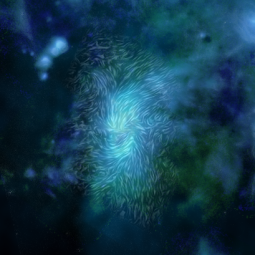By Joan Schmelz (USRA)
Even in a region where gravity dominates, there could be areas where magnetic fields govern the physics. The earth’s magnetosphere and the solar corona are two well-known examples. Although the gas in the central five parsecs of the Milky Way is largely neutral, the high fluxes of X-rays and cosmic rays ensure that there is sufficient residual ionization to collisionally couple the ions and neutrals. Consequently, the gas can react to the magnetic field, making the plasma beta (β) a useful indicator of the importance of the magnetic field in the environment. β is the ratio of the thermal pressure to the magnetic pressure. If the thermal pressure is greater than the magnetic pressure, then β > 1 (referred to as a high-β plasma), and the gas dynamics will control the structure of the environment. The magnetic field may be present, but it does not dominate, as is the case in the solar photosphere. If the thermal pressure is less than the magnetic pressure, then β < 1 (referred to as a low-β plasma), and the magnetic field can control the dynamics of the environment as it does in the magnetosphere and the corona.
The HAWC+ instrument on SOFIA is providing high-quality polarization measurements for astrophysically interesting environments including the Galactic Center. We used these data and the Davis-Chandrasekhar-Fermi method to determine the component of the magnetic field strength in the plane of the sky. This method relates the line-of-sight velocity dispersion and the plane-of-sky polarization angle dispersion. It assumes an isotopically turbulent medium whose turbulent kinetic and turbulent magnetic energy components are in equipartition. Results indicate that B ~ 5 milliGauss, similar to the values determined for the line-of-site component of the magnetic field measured using the Zeeman Effect. Using this estimate for the magnetic field as well as values for density and temperature from the literature, we found β ~ .0001 for the overall region and β ~ .001 for sub-regions like the Western Arc and the Northern Arm.
This is clearly in the low-beta regime, but observations tell us that turbulence is important in this region, and the traditional plasma beta does not account for this. Defining β’ as the ratio of the turbulent-to-magnetic pressure and using a velocity dispersion from the literature, we find β’ ~ 0.03. This too is in the low-beta regime, indicating that the magnetic field is capable of channeling the matter. So even though gravity dominates in the Galactic Center, there appear to be regions near the central black hole where the physics may be governed by the magnetic field.
These results have implications for two long-standing mysteries about the Galactic Center region. The first is about star formation. Even though there is an abundance of raw material, the amount of star formation is significantly less than expected. The second is about activity. Black holes at the centers of many galaxies are active, but ours is relatively quiet. A strong magnetic field could solve both these mysteries. It could suppress star formation, and it could keep the black hole from swallowing the matter it needs to form jets.
Future work will include updating the Davis-Chandrasekhar-Fermi method to work in the high-shear regions near the massive black hole. Detailed magneto-hydrodynamic modeling will also be required to explore the interplay between the magnetic field, the tidal stresses, and the turbulent motions of the gas in this extreme environment.
